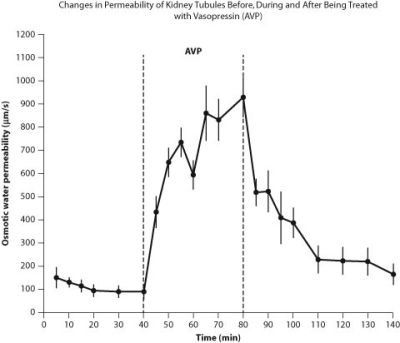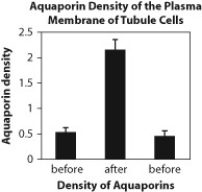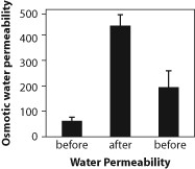Multiple Choice
Water movement is important in urine formation in the kidneys. Urine is formed when the blood is filtered by the kidneys into kidney tubules. Three figures are presented here that relate to how the kidney tubules respond to the administration of the hormone vasopressin. The direction that water flows in these figures is from the kidney tubules back into the blood.
 Figure A. Changes in permeability of tubules in the kidney in response to the hormone vasopressin (AVP) , which aids in osmoregulation.
Figure A. Changes in permeability of tubules in the kidney in response to the hormone vasopressin (AVP) , which aids in osmoregulation.
 Figure B. Density of aquaporins in kidney tubule cells before, during, and after administration of vasopressin.
Figure B. Density of aquaporins in kidney tubule cells before, during, and after administration of vasopressin.
 Figure C. Permeability of tissues to water before, during, and after administration of vasopressin.
Figure C. Permeability of tissues to water before, during, and after administration of vasopressin.
-How do the data in Figure A relate to the data in Figures B and C?
A) Figure B shows the method used to obtain the data in Figure A.
B) Figure C is essentially a summary of the data in Figure A.
C) Figure A is about water movement, and Figures B and C are about presence of aquaporins.
D) Figure A has data for more than 2 hours, and Figures B and C show data all collected at the same time.
Correct Answer:

Verified
Correct Answer:
Verified
Q71: Anything that prevents ATP formation will most
Q72: How does inhibition of an enzyme-catalyzed reaction
Q73: Some protozoans have special organelles called contractile
Q74: Which of the following statements regarding enzyme
Q75: Which of the following statements about ATP
Q76: Suppose that while the reverse osmosis system
Q77: The cholesterol associated with animal cell membranes<br>A)
Q78: An energy barrier<br>A) is the amount of
Q79: Which of the following processes is endergonic?<br>A)
Q80: Most of the functions of a cell